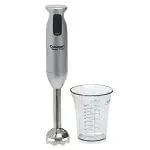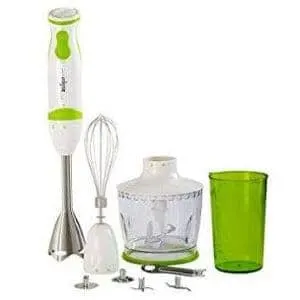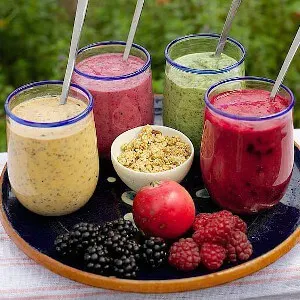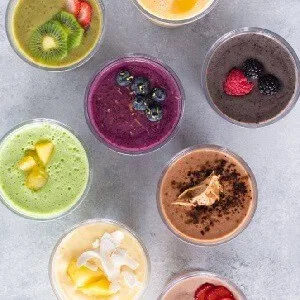 If you’ve been eyeing a hand blender, or immersion blender, and wondering if it’s worth it, let me be the first to tell you it absolutely is. But what are immersion blenders used for? This is the main question everyone always asks. They understand the concept of the hand blender but don’t quite get what you would use it for. Is it for smoothies, for mixing eggs, for making batter and dough? Today we will find out.
If you’ve been eyeing a hand blender, or immersion blender, and wondering if it’s worth it, let me be the first to tell you it absolutely is. But what are immersion blenders used for? This is the main question everyone always asks. They understand the concept of the hand blender but don’t quite get what you would use it for. Is it for smoothies, for mixing eggs, for making batter and dough? Today we will find out.
First of all, a hand blender is also known as an immersion blender. There is literally no difference between these two machines. They are the exact same thing. But depending on who you talk to, it is either a hand blender or an immersion blender.
Second of all, hand blenders can be used for literally anything. They have lots of different uses, from mixing a smoothie directly into your glass to making a yummy salad. You can use it for mixing vegetables without making a mess, and even for dicing onions without getting your eyes all watery. There are all kinds of exciting uses for a hand blender.
And third of all, hand blenders are 100% worth it. Let me tell you why.
Yes, Hand Blenders Are Great
 Hand blenders take up almost no space. You can stick them anywhere, from inside a drawer to inside a utensil container. They are very small and great for people who have a tiny kitchen space. Hand blenders are also extremely cheap. You can get a standard hand blender for $10 or a premium hand blender for just $40. They rarely go over this price point.
Hand blenders take up almost no space. You can stick them anywhere, from inside a drawer to inside a utensil container. They are very small and great for people who have a tiny kitchen space. Hand blenders are also extremely cheap. You can get a standard hand blender for $10 or a premium hand blender for just $40. They rarely go over this price point.
Hand blenders are also super versatile, you can do almost anything with them. And they can do it all very fast. It doesn’t take much longer than 30 seconds to fully blend an entire smoothie just by sticking your hand blender into your glass of ingredients.
And if you use the hand blender properly, there is almost no cleanup. There are fewer dishes to clean, and you don’t have to worry about scrubbing a massive countertop blender. The hand blender itself easily rinses clean under tap water.
To sum it up – less cleaning, less expensive, faster than a standard blender, versatile, and they take up almost no space. If you haven’t tried a hand blender, you should consider giving it a shot.
Read More: 7 Immersion Blender Substitutes – Best Hand Blender Alternatives
Immersion Blender Basics
Immersion blenders are quite different from standard blenders. While a normal blender uses a glass receptacle and a blade assembly to blend food and liquid, an immersion blender is more like an electric hand whisk.
An immersion blender is designed for you to use it as a tool, placing it inside the food or liquid to mix and blend the substance. Immersion blenders don’t have any containers or receptacles. You can place the immersion blender directly in a bowl and use it to whisk eggs, to mix batter, or to blend a liquid.
This may sound less convenient than using a traditional blender, but it is actually quite easy. Immersion blenders can be used to replace a handful of outdated kitchen appliances, and are especially handy when making soups, sauces, and other recipes that require being pureed.
If you are interested in a handheld electric blender that’s easy to clean, easy to use, and can dramatically improve your time in the kitchen, you probably want an immersion blender. It’s almost like having a magic wand that you stick into a bowl to do the mixing for you!
How Do You Use an Immersion Blender?
Using an immersion blender is very easy. Simply pour your ingredients into a pot, glass, or bowl, and insert the immersion blender. You can do this with eggs, with raw ingredients, or with a drink you want to be mixed better.
Insert the immersion blender into your food or liquid and begin blending by activating the power button. You generally want to start on the lowest power setting and then gradually increase the speed. As the blades of your blender turn, they will break apart any chunks or solid bits that remain in the liquid. And as they spin faster and faster, they will mix the entire batch of liquid until it’s the perfect texture.
Be sure that you never start the immersion blender until it is fully submerged in whatever you’re blending. If you start the immersion blender and then lower it into the bowl of liquid, you are going to get a lot of splashback, and it will be a pretty big mass.
While most immersion blenders are used for blending liquid, there are a lot of different applications you can use them for. They aren’t really designed for ice or hard ingredients, but they can still be used for grinding grains and even coffee beans.
However, you will need a proper container for doing this. Many immersion blenders come with convenient accessories and mixing bowls. In this case, you simply pour the dry ingredients into the bowl and then activate the blender, and it will create a whirlwind, with your blades gradually dicing your dry ingredients into a powder.
The blender can work the same way for chopping vegetables. If you need to chop an onion, simply throw it into the bowl and activate your immersion blender. It will chop the onion into small bits to save your eyes and your hands. No more crying with the use of an immersion blender!
Read More: Will an Immersion Blender Scratch Pots?
The Benefits of an Immersion Blender
Using an immersion blender has lots of great benefits. It’s quicker than using a blender since there is no transferring of liquid between bowls. An immersion blender is also a great way of getting ingredients ready while your soup is cooking. You can easily chop all your veggies and fruits using an immersion blender while getting the other parts of the recipe prepared.
Plus, you can leave the entire soup in the pot and mix it using the immersion blender rather than pouring the soup into different bowls. If you are making a salad, you can even use the immersion blender directly in your large salad bowl to chop apart thicker veggies and to dice the lettuce.
One of the best parts of using an immersion blender is the cleanup. There is not much to clean. You don’t use any extra dishes, so there is no extra cleaning in that department. Plus, the blender itself can be washed by hand under the tap in just a few seconds. And if you want to do a deep clean, almost all immersion blenders can be disassembled and then put in the dishwasher.
It may take a bit of practice to master an immersion blender, also known as a hand blender, but it’s well worth it. You won’t ruin any dishes, you won’t have to mess around with a giant countertop blender, and your cleaning time will be cut in half.
Read More: Is An Immersion Blender Dishwasher Safe: 3 Top Tips
How Much Are Immersion Blenders?
Immersion blenders are also way cheaper than standard blenders. I mean, way cheaper! While a standard blender can cost anywhere from $100 to $1000, a typical immersion blender costs less than $100. Even the most impressive hand blenders rarely cost more than the worst blender.
For example, you can get a standard immersion blender for about $10. This is not going to be the best model, but by investing another $20 or $30, you can get a serious immersion blender that comes with all the accessories you need for dicing vegetables, grinding dry grains, and mixing soups.
If you’re wondering why you’ve never heard of these before, it’s because they’re kind of a secret in the world of cooking. Many professionals use them, but you don’t see them advertised too much. I highly suggest trying a cheap immersion blender to see if you like it. Once you realize all the great benefits of using an immersion blender, you are probably going to run out and buy a professional model!
Uses for a Hand Blender
 As I already said, there are lots of different uses for a hand blender. Just to give you an idea of all the exciting things you can do with your new hand blender, I have composed a list of some of the most common uses for this type of blender. There are obviously far more uses, but this is a great place to start getting ideas.
As I already said, there are lots of different uses for a hand blender. Just to give you an idea of all the exciting things you can do with your new hand blender, I have composed a list of some of the most common uses for this type of blender. There are obviously far more uses, but this is a great place to start getting ideas.
Apple Butter
Have you ever wanted to make apple butter but felt too lazy? Well, if you have a bowl full of chopped apples, some cinnamon, a bit of lemon juice, and a splash of maple syrup, you can make your own apple butter in about 10 seconds by using your hand blender.
You of course need to first cook your apples in the oven until they have been reduced to slime, but then all you need to do is insert your hand blender and power on for a few seconds until your cooked, mushy apples turn into a deliciously smooth butter. You can then faceplant into the bowl or spoon it into your face.
Whipped Cream
Whipped cream is one of the biggest pains and the neck to make. But when you have a hand blender, you can do it in just 30 seconds. Take an empty beaker, add a tablespoon of powdered sugar, about half a cup of heavy cream, then stick your hand blender into the beaker for about 15 seconds. You will have transformed these two simple ingredients into a delicious whipped cream. If that’s not convenient, I don’t know what is.
Tomato Sauce
Tomato sauce is another easy thing to make with your hand blender. You don’t need to peel the tomatoes, you don’t need to seed the tomatoes, you only need your hand blender.
First, you are going to wash your tomatoes, then chop them into quarters or halves, throw them all in a pot, cook them until they have been reduced to mush just like your apple butter, remove the pot from the heat and let cool for about 15 minutes, then hit it with your hand blender and watch a pot of gross-looking melted tomatoes turn into a delicious tomato sauce that you can use on your next pasta.
Smoothies
Yes, you can blend smoothies with a hand blender. This is actually one of the easiest ways to prepare your morning smoothie without making a huge mess or wasting any time. Making a smoothie with a traditional blender is time-consuming, dirty, and way too loud.
Toss some fruit and veggies, frozen yogurt, and just enough liquid to cover your ingredients into a glass, then add your hand blender for about 30 or 60 seconds until all the ingredients have been mixed to perfection. You will have a smoothie in no time with only your small hand blender to clean and the glass that you will be drinking out of. It’s perfect!
Pancake Batter
One of the biggest reasons I avoid making pancakes in the morning is because of the huge mess and my horrible laziness. But with the addition of a hand blender, making pancakes becomes a lot easier. It definitely becomes way faster. And the best part is that you only need your pancake mix and a plastic beaker – no annoying mixing bowls!
The first step is to add all the ingredients for your favorite pancake mixture into your plastic beaker. Once you have all the ingredients added, simply begin working it with your hand blender. Use the up-and-down motion to get all the egg and flour mixed into a creamy pancake batter. When it’s done, you can use the spout on your beaker to pour the pancake mixture into the pan for cooking.
Can You Make Smoothies with Immersion Blenders?
 Most people make their smoothies using a standard countertop blender. But can you make smoothies with immersion blenders? This is a popular question that needs a little bit of digging to answer. Can it be done? Is it worth the trouble? And what are the advantages?
Most people make their smoothies using a standard countertop blender. But can you make smoothies with immersion blenders? This is a popular question that needs a little bit of digging to answer. Can it be done? Is it worth the trouble? And what are the advantages?
The basics of an immersion blender suggest that you can indeed make smoothies with one, but you definitely can’t make giant batches. If you are looking for a single smoothie made in a glass jar, and you don’t want the hassle of a big and heavy countertop blender, an immersion blender might be the best choice for you.
Immersion blenders tend to be cheaper, they have quite a few interesting uses, and they have a surprising amount of power. Immersion blenders store easily out of the way, they don’t take up a lot of electricity, and many of them come with exceptionally strong blades and motors.
The short answer to this question is yes. You can absolutely blend a small serving using your immersion blender. If you have a quality hand blender with good blades, it can pulverize frozen fruit and vegetables just as well as your standard blender.
But there are a few differences. With a standard blender, all you need is to pour the ingredients into the container, activate the blender, and sit back and wait. But with an immersion blender, you have to pour all your ingredients into a container and then insert the immersion blender, at which point you take control over the blend.
This is a safe process, it takes about the same amount of time as a normal blender, but maybe a little bit longer, and it doesn’t create much of a mess. Although it is important to note that if you are thinking about making a smoothie inside of a small glass, you could expect quite a mess. It is better to make the smoothie inside a large container and then transfer it into a glass.
Can you make large batches with an immersion blender? Yes and no. An immersion blender is certainly powerful, but if you’re trying to blend 48 ounces of frozen fruit and vegetables, you are going to be at it for quite some time. I recommend a maximum serving of about 12 or 16 ounces per blend. This is about the same you would get with a standard NutriBullet Blender.
As a side note, if you don’t have a special beaker or container, you can definitely use a wide-mouth jar or glass container for mixing your smoothie in. When using an immersion blender, one of the most popular containers to use is a mason jar.
How to Blend a Smoothie with an Immersion Blender
 Now I will give you some great tips on how to make an easy smoothie using your immersion blender. Because the blades are so small and concentrated in a tiny area, you want to have smaller pieces of fruit and vegetables. For example, if you are blending a frozen banana, try cutting it into small pieces and dropping each piece into the beaker or jar.
Now I will give you some great tips on how to make an easy smoothie using your immersion blender. Because the blades are so small and concentrated in a tiny area, you want to have smaller pieces of fruit and vegetables. For example, if you are blending a frozen banana, try cutting it into small pieces and dropping each piece into the beaker or jar.
When blending kale or spinach, be sure to pack the leaves at the bottom and then attack them with your immersion blender. Blueberries and strawberries are simple enough, while nut butter, soft fruits, and seeds should go into the mixture last. Any hard seeds or nuts should be sprinkled into the mixture once the softer ingredients have already been blended. This will make it easier to blend hard things.
Never forget the liquid base. You want enough liquid inside the container, using either some kind of milk or some kind of water so that the ingredients are submerged. If your immersion blender is not completely immersed in liquid, you are going to get a lot of splatters and it won’t blend your ingredients properly.
Think about driving your lawnmower over a puddle. This is what will happen if you start blending before your immersion blender is underneath the liquid. Always start beneath the liquid. Once you are submerged, press the button to activate the immersion blender. You will then want to move the machine up and down to get all the little pieces blended.
Sometimes little chunks can clog your blender, and if this happens you simply need to unplug the machine and then pick out the hard chunk. Whatever you do, never put your fingers inside the blender unless it is unplugged. It is way too easy to accidentally hit the button and chop a few of your fingers off.
Benefits of Using an Immersion Blender For Smoothies
Believe it or not, there are actually quite a few advantages to using an immersion blender rather than a standard countertop blender. First of which is the cleaning aspect. Immersion blenders are very easy to clean. Simply rinse your tool underwater, give it a bit of a scrub, then let it dry on the counter. All the corners and crevices are easy to reach with a cloth.
Then there is the price. Immersion blenders are quite cheap, and you generally won’t pay more than $50 or $100 for a quality unit. This is a stark contrast to an expensive countertop blender that could cost you upwards of $500.
A lot of people enjoy the control they get with an immersion blender as opposed to a standard blender. You actually blend the drink with your hands, moving the blender up and down until you have reached the perfect temperature. This is ideal for some people and a hassle for others. So, it really comes down to preference.
Finally, immersion blenders can be used for a wide variety of different tasks. They can certainly blend, but they can also be used to grind dry grains and chop vegetables. If you want a smart way to chop onions when preparing a meal without getting your eyes watery or accidentally cutting off your thumb, and immersion blender can do it for you.
To sum everything up, an immersion blender can definitely make your smoothies. It is cheaper than a normal blender, easier to clean, and it has a lot of useful applications.
Can I Make Powders With Hand Blenders?
A hand blender can do a lot of different things, and they also come with a wide variety of extensions and accessories. It is important to understand before we get into the exact list of what hand blenders can do that not all of them are created equally. Some cheaper hand blenders cannot perform every task on the list.
However, every quality hand blender can indeed do everything on the list. A quality hand blender will come with the right attachments and the right amount of power to do all your basic mixing and blending. Let’s take a detailed look at exactly what these great little machines can accomplish.
Aerating: Aerating is introducing air into your mixture, which is generally done by beating or whisking. You can do this with a hand blender, and it is generally used for beating eggs.
Blending: Hand blenders are excellent for blending, as the name would suggest. You can mix and combine all your ingredients to make a uniform mixture that is smooth and perfectly blended. All your ingredients will be blended together to create one unique mixture. A hand blender can replace a spoon or whisk for this task.
Chopping: Hand blenders are great for chopping larger ingredients into small portions rather than using a knife. Normally you would do this in a chopper bowl, and you would use the hand blender for chopping onions, celery, and anything similar.
Creaming: Creaming is the term used to describe creaming butter or any kind of buttery mix for baking. Rather than using an electric mixer or wooden spoon, you can very easily cream your mixture just with a hand blender.
Crushing: Crushing is similar to blending and pulverizing. This is when you take food and crush it into a smaller form by using your hand blender instead of a mortar and pestle. Using a hand blender to crush your ingredients takes away the strain of doing it yourself with your own hands. One of the most common things to crush is ice, and you had better make sure your blender is quality before using it to crush apart ice for a specific recipe.
Emulsifying: Emulsifying is like blending, only a little more hardcore and a little more difficult. Emulsifying involves blending two extremely different ingredients into one perfect emulsion. You can do this with a hand blender, but you will need to bring your patience along.
Foaming: This is not to be confused with frothing. Foaming is when you agitate a liquid to make it a type of foam. This is generally done with milk and a hand blender, but you can also do it by injecting hot steam into liquid milk.
Frothing: Frothing is what you get on your coffee house drinks, like a cappuccino or a macchiato. Frothing takes milk and turns it into a bubbly foam that you can slather onto a beverage. It makes the milk sweeter and lighter, and it turns it into a foam for mostly decorative purposes.
Read More: Froth Milk with an Immersion Blender: 3 Simple Steps
Grinding: Finally, we have come to grinding. This is what we came here for, to discover if you can make powders with a hand blender. And the answer to the question is a resounding yes! You can absolutely grind nuts or spices into powder by using your hand blender.
This is typically done using either a food processor or a spice grinder, or even a special coffee grinder or bean grinder. However, it can indeed be done with a hand blender. As you have already seen from this long list of blender capabilities, grinding is no big deal with a hand blender!
This is a great specialized tool that can grind your coffee beans, your spices, and your nuts into a fine powder. You can then use that fine powder for cooking, for adding into smoothies, or for putting into capsules and taking as a supplement. You can also use a hand blender for grinding coffee beans into coffee grounds.
Stirring: Hand blenders are excellent for stirring ingredients instead of using a spoon or a spatula. You can set the hand blender to a low speed and use it for stirring, which will be much quicker and less painful than using a spoon and your hand.
Whipping & Whisking: Whisking is one of the most annoying preparations when baking or making food. Nobody likes standing over the bowl and whisking with that giant balloon-shaped wire mixer. However, you don’t have to do it anymore! You can now use a quality hand blender to do all the whisking for you. Put the whisk and the fork down and pick up your hand blender.
Can I Make Powders With An Immersion Blender?
As you can see, you get infinite uses out of a hand blender. These tools are easy to store, you can keep it in a drawer rather than have to stand it up in a cupboard, and they just take a minute to clean. You can use them for stirring, shredding, pulverizing, and even mashing.
And you can definitely use a hand blender for grinding and making powders. Throw away the outdated mortar and pestle and get yourself a hand blender! You can use it to turn all your spices into fine powders.
Can I Whisk Eggs with a Hand Blender?
 Have you ever thought about whisking eggs with a hand blender? This is such a complicated subject, and there are so many different reasons to use a hand blender for whisking eggs. There are also lots of reasons not to use a hand blender for whisking eggs.
Have you ever thought about whisking eggs with a hand blender? This is such a complicated subject, and there are so many different reasons to use a hand blender for whisking eggs. There are also lots of reasons not to use a hand blender for whisking eggs.
I will go through lots of different theories about eggs and hand blenders, how to properly use a hand blender to whisk eggs, when it is necessary to do so, and when it is not necessary. Keep in mind that hand blenders are extremely strong mobile blenders that can be used for a handful of tasks. If you don’t know what you’re doing, you could end up ruining your eggs.
There are some situations where using a hand blender simply doesn’t make sense. For example, if you are making an omelet, I would not recommend using any kind of powered machine. A hand blender is absolute overkill for an omelet. It will give your egg whites way too much aeration.
This kind of warning applies to any type of situation where you don’t need a lot of heavy blending. Definitely save your hand blender for egg tasks that require significant whisking. Though on the other hand, many quality hand blenders come included with a classic whisk attachment, which can be used to replace a fork even in smaller tasks like getting extra air into an omelet. But use it sparingly.
Whisking Egg Whites with a Hand Blender
If you really want to get your omelets nice and fluffy, to get your eggs mixed nicely for a pancake batter or cookie dough, whisking eggs with a hand blender could be an easier way to go about it. There are basically two foods your hand blender is going to be the best at whisking. These are egg whites and whipped cream.
If you are making meringue pie, angel food cake, or any other type of recipe that uses a lot of egg whites, you will greatly benefit from using your hand blender. Your hand blender works quicker, it doesn’t hurt your wrists, and it’s actually kind of fun.
A hand blender will also help you fold the egg whites into your main batter using a high and consistent speed. This will allow you to get the stiff peaks of fluffiness that you can then use for folding. When you remove the blender from your mixture, you will notice a peek of stiff egg whites form in its wake. You will also notice that this peak will remain standing, and that is exactly what you want when whisking egg whites.
During your whisking, remember to try and keep the blender arm at the very bottom of the mixing bowl to prevent any possible spilling. And always start the hand blender once it is fully submerged. Don’t start it and then lower it into the mixture or you will spray yourself with eggs.
General Whisking Tips
When you are whisking egg whites, you always want to keep the bowl and the whisk completely free of unwanted food residue, such as oil. If you have food chunks or slime on your hand blender, it could interrupt your egg whites reaching the point where they are perfectly peaked and fluffy.
I recommend spraying down your hand blender and the bowl with a vinegar/water solution. Then you want to wipe it down so it’s perfectly dry. Any kind of residual moisture will have the same negative impact as oil residue.
Another great tip is that the best egg whites for whipping with your hand blender are going to be fresh and cold. It also helps if you chill the bowl you’re using beforehand so that you can keep the egg whites colder for longer.
And never use a bowl that is too small. Make sure you have an enormously big bowl with lots of room for your egg whites. Once you get into some serious mixing with your hand blender, your egg whites can double or triple in volume, or even more! You always want enough room for your egg whites to grow.
I also recommend that you use a copper bowl when whisking your eggs. This is an old trick that uses some science that barely I understand. But basically, the copper ions of the copper bowl will mix with a special protein found in the eggs, which results in a mixture that is much more stable than only whisking the eggs on their own. It sounds like witchcraft, but the copper actually binds with eggs much better than using a plastic or metal container.
By using the copper bowl, you will be less likely to overbeat the eggs with your hand blender and thereby turn it into a grainy mess. But this doesn’t mean you can’t use a steel, ceramic, or glass mixing bowl. The only type I don’t recommend is plastic, as plastic can be somewhat of a nightmare.
Can I Whisk Eggs with A Hand Blender?
To sum up everything, you can absolutely whisk eggs with a hand blender. In fact, you can use a hand blender to replace a whisker, a mixer, or anything else that works similarly. You can use your hand blender for scrambled eggs, for batter, for mixing whipped cream, and you can use it for about 3 dozen other kitchen applications.
However, most eggs need to be whisked gently. Scrambled eggs for example are generally fine if you use a fork or a whisk. If you use a hand blender, you will probably scramble your eggs beyond a reasonable level of scrambled. You would have to use a very low setting and be very careful.
When it comes to aggressive mixing and whisking, that is where the hand blender really shines. You can definitely beat eggs mercilessly using a hand blender. Just keep in mind that you should move your hand blender around so that the blades are near to the surface of your liquid mixture, as this will draw sufficient air into the mixture.
What Are Immersion Blenders Used For: Final Thoughts
Anyone can pick up an immersion blender and start using it. They work with a small motor inside the handle that spins the blades so that you can blend, chop, and mix using the blender like a wand. These are excellent kitchen tools that every serious cook should have on hand.
